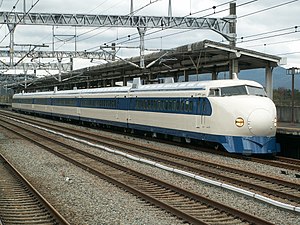0 Series Shinkansen
| 0 series | |
|---|---|

0 series 6-car set at Higashi-Hiroshima Station, April 2008
|
|
| In service | 1 October 1964 – 14 December 2008 |
| Manufacturer | Hitachi, , Kinki Sharyo, Kisha, Nippon Sharyo, Tokyu Car Corporation |
| Constructed | 1963–1986 |
| Number built | 3,216 vehicles |
| Number in service | None |
| Number preserved | 27 vehicles (as of September 2011) |
| Formation | 4, 6, 8, 12 or 16 cars per trainset |
| Capacity | 368–1,340 |
| Operator(s) |
JNR (1964–1987) JR Central (1987–1999) JR-West (1987–2008) |
| Depot(s) | Tokyo, Shin-Osaka, Hakata |
| Line(s) served | Tōkaidō Shinkansen, Sanyō Shinkansen, Hakata-Minami Line |
| Specifications | |
| Car body construction | Steel |
| Car length | 25,000 mm (82 ft 0 in) (intermediate cars), 25,150 mm (82 ft 6 in) (end cars) |
| Width | 3,383 mm (11 ft 1.2 in) |
| Height | 4,490 mm (14 ft 9 in) |
| Maximum speed | 210 km/h (130 mph) (1964–1986) 220 km/h (140 mph) (1986–2008) |
| Traction motors | Brushed DC motor, 185 kW (248 hp) each |
| Transmission | Secondary-side tap changer drive |
| Acceleration | 1.0 km/(h·s) (0.62 mph/s) (1964–1992) 1.2 km/(h·s) (0.75 mph/s) (1992–2008) |
| Deceleration | 2.84 km/(h·s) (1.76 mph/s)s |
| Electric system(s) | 25 kV AC, 60 Hz, overhead catenary |
| Current collection method | Pantograph |
| Safety system(s) | ATC-1 |
| Track gauge | 1,435 mm (4 ft 8 1⁄2 in) |
The 0 series (0系 Zero-kei?) trains were the first Shinkansen trainsets built to run on Japan's new Tōkaidō Shinkansen high-speed line which opened in Japan in 1964. The last remaining trainsets were withdrawn in 2008.
The 0 series (which were not originally classified, as there was no need to distinguish classes of trainset until later) entered service with the start of Tōkaidō Shinkansen operations in October 1964. These units were white with a blue stripe along the windows and another at the bottom of the car body, including the front pilot.
Unlike previous Japanese trains, the Tōkaidō Shinkansen and all subsequent Shinkansen lines were standard gauge (1,435 mm (4 ft 8 1⁄2 in) between the rails). The trains were powered by 25 kV AC electricity at 60 Hz with all axles of all cars powered by 185 kW traction motors, giving a 220 km/h (140 mph) top speed.
The original trains were introduced as 12-car sets, with some sets later lengthened to 16 cars. Later, shorter trains of 6 cars and even 4 cars were assembled for lesser duties. Production of 0 series units continued from 1963 until 1986.
Shinkansen sets are generally retired after fifteen to twenty years. The final remaining 0 series sets were 6-car sets used on JR-West Kodama services on the Sanyō Shinkansen between Shin-Osaka and Hakata, and on the Hakata-Minami Line until their retirement on 30 November 2008.
Following retirement from regular service, JR-West ran a number of special commemorative Hikari runs in December 2008.Hikari 347, powered by set R61, arrived at Hakata Station at 6:01 pm on 14 December 2008, bringing to an end the 44 years of service of the 0 series trains.
...
Wikipedia
